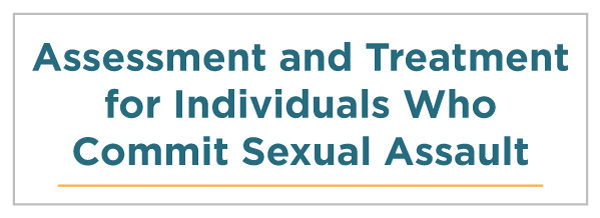
 |
 |
 |
 |
Most SARTs’ missions revolve around three key ideas: supporting victims, holding offenders accountable, and increasing community safety. While SARTs have been largely successful in these efforts, some SARTs are exploring additional strategies regarding offender accountability.
One promising area is an expanded collaboration with professionals who assess, treat, and manage sex offenders. This professional collaboration and a deeper understanding of the individuals who commit sexual assault can inform investigation and prosecution, create stronger networks for prevention and treatment, and establish safer communities. [1] These collaborations may be especially important in close-knit communities, where the assault, the trial, and the outcomes have collateral implications for the community, and the community’s reaction can have devastating impact on the victim.
Given the numbers of individuals who have committed sexual offenses who live in communities across the United States, increasing your SART’s understanding of these individuals is critical to addressing this significant public safety and public health issue. [2]
- Over 860,000 people on the sex offender registry have been convicted or adjudicated for a sexual assault, according to the National Center for Missing and Exploited Children. [3]
- As many as two-thirds of those convicted of a sexual assault are sentenced to community supervision, and 700,000 individuals are on community supervision in the United States. [4]
- An estimated 95 percent of individuals in prison for a sex crime will ultimately be released back to communities. [5]
SARTs can use the information in the following sections to identify opportunities for collaboration, consider the ways current data informs SART work (supporting victims, receiving a report, investigation, and prosecution), and ensure that the process remains victim-centered as the team learns more about offender accountability through assessment, treatment, and management of these individuals.
Effective Collaborations
A SART that chooses to collaborate with professionals responsible for sex offenders will likely gain a new perspective on this complex issue. SARTs can expand their important role in promoting a strong, culturally relevant, victim-centered, trauma-informed approach to sexual assault, to include the assessment, treatment, and management of sex offenders. [6]
Collaboration Supports Victims
For victims, a guilty conviction is just one point in a long journey of engaging with systems and the offender(s). With information about what happens to the offender after conviction, SARTs can support victims to make informed decisions through the entire process, including the initial disclosure, medical exam, report to law enforcement, investigation, prosecution, conviction, offender incarceration, offender probation/parole, and an offender’s return to the community.
Collaboration Supports SART Goals
Many SARTs engage in community education and prevention as necessary measures to replace misinformation about sexual assault with a fair and accurate understanding of the crime. In collaborating with professionals focused on offender accountability, SARTs will enhance their understanding of the risk and protective factors that affect individuals who commit sexual offenses as well as management and treatment strategies that can help prevent future sexual assaults.
Knowledge of both victims’ experiences and the dynamics of sex offenders’ behavior can inform more effective community education and prevention efforts as SARTs work toward the goal of a safer community.
Collaboration Supports Communities
Given that a significant number of offenders are never reported and therefore never enter the criminal justice system, information from those who work with offenders may help SARTs and member agencies enhance their prevention efforts. In addition, with the number of offenders returning to the community, understanding re-entry strategies can ensure a safer community.
Collaboration Ensures a Victim-Centered Process Over Time
Increasing the connection between SARTs and offender management programs may provide SARTs with a full understanding of the connection between everyone’s efforts and long-term outcomes. If service providers only engage with victims during initial service provision, then no one has access to feedback about offender outcomes or information about the impact of their efforts on offender behavior in a case or over time.
To begin the process, SARTs may want to conduct a community assessment to determine who provides what services to adults or adolescents who have committed a sexual assault. Every community is unique in its approach to sex offender management. Some communities may have multiple professionals who specialize in sex offender management, including probation, parole, and re-entry. Other communities may have one person responsible for a multitude of roles related to sex offender management.
Through the process, SARTs may identify gaps in systems that greatly impact victim wellbeing. For example, if there are insufficient parole officers, victims may not receive timely notification, or any notification, around sex offender parole or release. Ensuring that every part of the system is intact is the most effective way to support victims.
While these relationships are unique to each community, a few examples of effective collaborations between victim service programs and professionals who work with sex offenders are provided below:
In Connecticut, victim representatives are embedded in sex offender management programs to support victims and to manage and supervise those who commit sexual assaults. [7] This connection provides a victim-centered approach in the management of offenders and makes information available to victims about how the offender is responding to treatment. Collaboration can be especially useful in cases where the offender committed sexual assault against a family member. [8]
The SART in Jefferson County, Colorado, has sex offender management and treatment professionals join SART meetings to discuss new cases. This process provides enhanced services to both adolescents who commit acts of sexual assault, as well as those who are sexually assaulted and their families. The collaboration has enhanced cross-training and increased resource-sharing, which ultimately can lead to a safer community.
The National Sexual Violence Resource Center and the Resource Sharing Project are collaborating with the Association for the Treatment of Sexual Abusers (ATSA) and the Center for Sex Offender Management on a study exploring cross-training between professionals working with those who commit sexual assaults and those working with victims. This project is intended to document the shared interest and positive examples of collaboration across these professionals.
Read the joint publication, Promoting Collaboration Between Victim Advocates and Sex Offender Management Professionals: A Resource Package, for more information.
Some SARTs develop a memorandum of understanding (MOU) to articulate shared values and guide their work with those who treat and manage individuals who perpetrate sexual assault. Written protocols can also be helpful for SARTs to institutionalize their work addressing sex offender management and treatment.
| Back | Index | Next |
